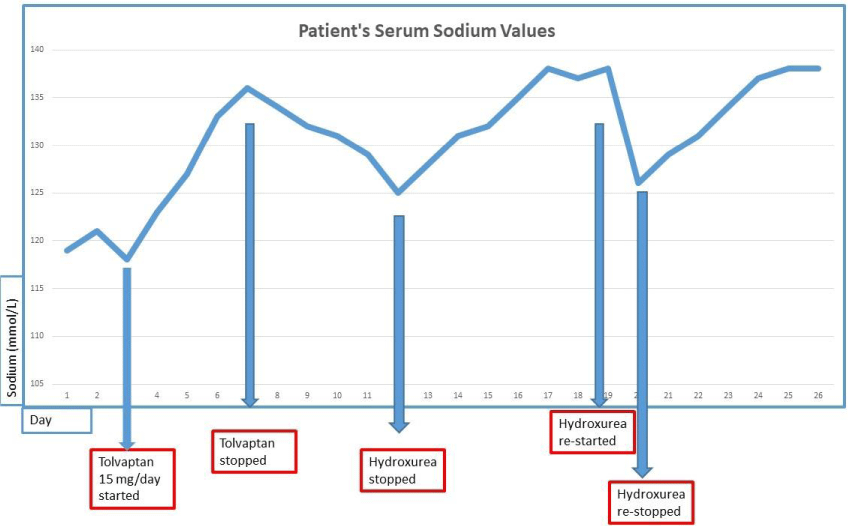Archives of Clinical Nephrology
Syndrome of Inappropriate Antidiuretic Hormone secretion due to hydroxyurea
Hakan Ozer*, Yasin Ozturk, Ismail Baloglu and Kultigin Turkmen
Cite this as
Ozer H, Ozturk Y, Baloglu I, Turkmen K (2022) Syndrome of Inappropriate Antidiuretic Hormone secretion due to hydroxyurea. Arch Clin Nephrol 8(1): 028-30. DOI: 10.17352/acn.000060Copyright License
© 2022 Ozer H, et al. This is an open-access article distributed under the terms of the Creative Commons Attribution License, which permits unrestricted use, distribution, and reproduction in any medium, provided the original author and source are credited.Hyponatremia is the most common electrolyte disorder in clinical practice: Syndrome of Inappropriate Antidiuretic Hormone Secretion (SIADH) is the most common cause of hyponatremia, especially in euvolemic patients. Drugs are among the most common causes of SIADH. While our patient was using hydroxyurea due to polycythemia vera, he was diagnosed with SIADH due to hydroxyurea treatment after investigation due to resistant hyponatremia. The improvement of hyponatremia after hydroxyurea is discontinued and the development of hyponatremia after the drug is re-started supports the development of drug-induced hyponatremia. Careful follow-up is required in terms of hyponatremia in patients using hydroxyurea.
Introduction
Hyponatremia is the most common electrolyte disturbance in clinical practice and is directly related to increased mortality and prolonged hospitalization [1]. Syndrome of Inappropriate Antidiuretic Hormone Secretion (SIADH), first defined as hyponatremia due to renal sodium loss in two patients with lung cancer, is a disease in which Antidiuretic Hormone (ADH) levels or renal ADH response are inappropriately high [2]. Despite the low osmolarity in the plasma in SIADH, high ADH response causes extracellular fluid retention and hyponatremia. The most common cause of euvolemic hyponatremia is SIADH. Intracranial pathologies, malignancies and drugs (especially serotonin reuptake inhibitors, cyclophosphamide, non-steroidal anti-inflammatory drugs, opioids), surgical stress, and lung diseases are essential in the etiology of SIADH. Management of hyponatremia is based on identifying and treating the underlying causes; however, it is difficult to accurately determine the etiology of hyponatremia, especially in elderly patients.
While drugs are the most common causes of hyponatremia, diuretics (especially the thiazide group) are the most common drugs causing hyponatremia. After diuretics, antidepressants, antipsychotics, and antiepileptics are known as agents that cause hyponatremia [3]. Although there are long lists of drugs that cause hyponatremia, only one case has been reported due to hydroxyurea [4].
Case presentation
A 67-year-old male patient was admitted to our clinic (Konya Necmettin Erbakan University/Turkey) complaining of dizziness, weakness, and altered consciousness. He was hospitalized after detecting serum sodium (Na) 119 mmol/L (134-145 mmol/L). The patient, who had no chronic disease and drug use, started hydroxyurea at 1000 mg/day due to polycythemia vera about 2 weeks ago. In the tests performed for his complaints, serum sodium and osmolarity were 119 mmol/L (134-145 mmol/L) and 248 mOsm/kg (280-295 mOsm/kg), respectively; urine sodium and osmolarity were 101 mmol/L (< 20 mmol/L) and 553 mOsm/kg, respectively. Adrenal and thyroid functions were normal. The patient, who had no clinical signs of hypervolemia and dehydration and was evaluated as euvolemic hyponatremia, was accepted as SIADH. No pathology was found in malignancy scans for the etiology of SIADH (upper-lower GIS endoscopies, thorax-abdominal tomography, and lymphadenopathy scans). There was no use of additional herbal products that could cause SIADH and no new drug use other than hydroxyurea. Due to hyponatremia resistant to fluid restriction and hypertonic saline infusion, tolvaptan 15 mg/day was started, and serum sodium level increased to the normal range. After the tolvaptan treatment was discontinued, hyponatremia developed again, and it was thought that it might be hyponatremia due to hydroxyurea treatment. When the literature was reviewed, there was another case showing the development of hyponatremia due to the hydroxyurea that the patient was using. It was observed that the hydroxyurea treatment was discontinued, and the hyponatremia improved on the 4th day with fluid restriction in the follow-up [4]. In the follow-ups of the patient, serum Na was 138 mmol/L on the 10th day after discharge. After this test, the patient who started using hydroxyurea again applied to our polyclinic about one week later with complaints of weakness and inability to focus, and serum Na: 126 mmol/L was detected. Serum Na: increased to 136 mmol/L on the 4th day of the patient’s follow-up, whose medication was stopped and fluid restriction was made (Figure 1). The patient was discharged after being suggested not to use hydroxyurea again.
Discussion
We detected SIADH in a patient who recently started using hydroxyurea and developed hyponatremia after treatment. When the other pathologies causing SIADH were excluded, we thought that hyponatremia developed due to the use of hydroxyurea. By presenting this case, we wanted to draw attention to the fact that the development of hyponatremia in patients using hydroxyurea may be drug-related, in addition, the use of drugs should be questioned and screened in detail, especially in patients with euvolemic-hyponatremia.
Hyponatremia in patients receiving chemotherapy may be due to many reasons. The development of SIADH due to the underlying malignancy, decrease in extracellular fluid due to nausea and vomiting, reduction of oral intake, accompanying co-morbidities such as infection, increase in fluid volume due to chemotherapy, and adrenal insufficiency due to metastases to the adrenal gland may be the cause of hyponatremia in patients with a malignancy [5]. In the differential diagnosis, after excluding the above-mentioned etiologies, drug-induced hyponatremia should definitely be kept in mind. In our case, it was thought that hydroxyurea-induced hyponatremia might develop because there was no nausea and vomiting before hyponatremia, no signs of malnutrition, adequate oral intake, and no adrenal metastasis. Evaluated as 9/12 according to Naranjo drug side effect algorithm [6].
Drug-induced hyponatremia generally develops due to UADHSS and renal salt loss. The risk of developing hyponatremia due to hydration given with alkylating agents increases, and SIADH may develop even at low doses of alkaline agents. Chemotherapeutic drugs can cause hyponatremia by a variety of mechanisms. Some of these mechanisms are that vinca alkaloids change the release of AVP on the pituitary and hypothalamus, interferons and monoclonal antibodies cause SIADH, mechanistic target of rapamycin (mTOR) inhibitors cause secondary adrenal insufficiency, and lymphocytic hypophysitis and methotrexate increases the activation of natriuretic peptides. However, since the literature data on hydroxyurea is insufficient, it is not yet included in the list of drug-related hyponatremia. Studies on the mechanisms that cause hyponatremia are inadequate [7,8].
In the literature, only Watanebe, et.al. [4]. Showed in 2002 that hyponatremia was detected in a patient receiving hydroxyurea therapy for chronic myeloid leukemia and that hyponatremia resolved after the drug was discontinued. In this case, the ADH level was found to be within the normal range, and the case was evaluated as cerebral salt wasting. Drug-induced hyponatremia generally develops due to SIADH and renal salt loss. Hydroxyurea is not yet included in the list of drug-related hyponatremia since the literature data on the development of hydroxyurea-induced hyponatremia is insufficient. There are also insufficient data on the mechanisms of causing hyponatremia.
Considering the changes in consciousness, falls, and related fractures and deaths due to hyponatremia, hyponatremia is a clinical condition with high morbidity and mortality. Therefore, pharmacotherapy anamnesis gains importance in the diagnosis of drug-induced hyponatremia. Potentially culpable agents should be discontinued if they are present in the treatment, and if not essential, they should not be restarted. In this study, we wanted to emphasize that hyponatremia due to SIADH should be kept in mind in patients using hydroxyurea.
We did not have the opportunity to measure serum and urinary ADH levels in our case, but ADH levels are not currently among the diagnostic criteria for SIADH. However, the inability to measure ADH levels is one of the most critical limitations of this condition.
Informed consent: Informed consent was taken from the patient.
- Woodward M, Gonski P, Grossmann M, Obeid J, Scholes R, Topliss DJ. Diagnosis and management of hyponatraemia in the older patient. Intern Med J. 2018 Jan;48 Suppl 1:5-12. doi: 10.1111/imj.13682. PMID: 29318728.
- SCHWARTZ WB, BENNETT W, CURELOP S, BARTTER FC. A syndrome of renal sodium loss and hyponatremia probably resulting from inappropriate secretion of antidiuretic hormone. Am J Med. 1957 Oct;23(4):529-42. doi: 10.1016/0002-9343(57)90224-3. PMID: 13469824.
- Ramírez E, Rodríguez A, Queiruga J, García I, Díaz L, Martínez L, Muñoz R, Muñoz M, Tong HY, Martínez JC, Borobia AM, Carcas AJ, Frías J. Severe Hyponatremia Is Often Drug Induced: 10-Year Results of a Prospective Pharmacovigilance Program. Clin Pharmacol Ther. 2019 Dec;106(6):1362-1379. doi: 10.1002/cpt.1562. Epub 2019 Sep 10. PMID: 31247118.
- Watanabe N, Tani M, Tanaka Y, Kurata M, Matsushita A, Maeda A, et al. [Severe hyponatremia with consciousness disturbance caused by hydroxyurea in a patient with chronic myeloid leukemia]. Rinsho Ketsueki. 2004;45(3):243–6.
- Liamis G, Filippatos TD, Elisaf MS. Electrolyte disorders associated with the use of anticancer drugs. Eur J Pharmacol. 2016 Apr 15;777:78-87. doi: 10.1016/j.ejphar.2016.02.064. Epub 2016 Mar 3. PMID: 26939882.
- Naranjo CA, Busto U, Sellers EM, Sandor P, Ruiz I, Roberts EA, Janecek E, Domecq C, Greenblatt DJ. A method for estimating the probability of adverse drug reactions. Clin Pharmacol Ther. 1981 Aug;30(2):239-45. doi: 10.1038/clpt.1981.154. PMID: 7249508.
- Koumpis E, Florentin M, Hatzimichael E, Liamis G. Hyponatremia in Patients with Hematologic Diseases. J Clin Med. 2020 Nov 19;9(11):3721. doi: 10.3390/jcm9113721. PMID: 33228240; PMCID: PMC7699475.
- Krishnamurthy A, Bhattacharya S, Lathia T, Kantroo V, Kalra S, Dutta D. Anticancer Medications and Sodium Dysmetabolism. Eur Endocrinol. 2020 Oct;16(2):122-130. doi: 10.17925/EE.2020.16.2.122. Epub 2020 Oct 6. PMID: 33117443; PMCID: PMC7572166.
Article Alerts
Subscribe to our articles alerts and stay tuned.
 This work is licensed under a Creative Commons Attribution 4.0 International License.
This work is licensed under a Creative Commons Attribution 4.0 International License.



 Save to Mendeley
Save to Mendeley
